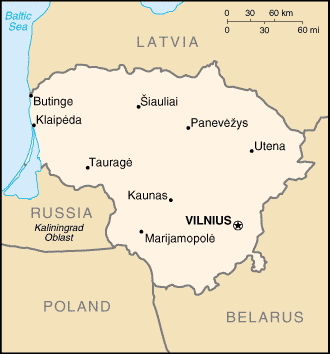
|
Lithuania
Background:
Independent between the two World Wars, Lithuania was annexed by the USSR in
1940. On 11 March 1990, Lithuania became the first of the Soviet republics to
declare its independence, but this proclamation was not generally recognized
until September of 1991 (following the abortive coup in Moscow). The last
Russian troops withdrew in 1993. Lithuania subsequently has restructured its
economy for eventual integration into Western European institutions.
Location:
Eastern Europe, bordering the Baltic Sea, between Latvia and Russia.
Area: Total: 65,200 sq km, water: NA sq km, land: NA sq km.
Area - comparative: Slightly larger than West Virginia.
Land boundaries: Total: 1,273 km, border countries: Belarus 502 km, Latvia 453
km, Poland 91 km, Russia 227 km.
Coastline: 99 km.
Climate and Terrain:
Climate: Transitional, between maritime and continental; wet, moderate winters
and summers.
Terrain: Lowland, many scattered small lakes, fertile soil.
Elevation extremes: Lowest point: Baltic Sea 0 m, highest point:
Juozapines/Kalnas 292 m.
Natural resources: Peat, arable land.
People:
Population: 3,601,138.
Ethnic groups: Lithuanian 80.6%, Russian 8.7%, Polish 7%, Belarusian 1.6%,
other 2.1%.
Religions: Roman Catholic (primarily), Lutheran, Russian Orthodox, Protestant,
Evangelical Christian Baptist, Muslim, Jewish.
Languages: Lithuanian (official), Polish, Russian.
Government type: Parliamentary democracy.
Government:
Capital: Vilnius.
Independence: 11 March 1990 (independence declared from Soviet Union); 6
September 1991 (Soviet Union recognizes Lithuania's independence).
Economy overview:
Lithuania, the Baltic state that has conducted the most trade with Russia, has
been slowly rebounding from the 1998 Russian financial crisis. High
unemployment, at 12.5% in 2001, and weak consumption have held back recovery.
Trade has been increasingly oriented toward the West. Lithuania has gained
membership in the World Trade Organization and has moved ahead with plans to
join the EU. Privatization of the large, state-owned utilities, particularly in
the energy sector, is underway.
GDP - composition by sector: Agriculture: 9%, industry: 32%, services: 59%.
Statistics:
Telephones - main lines in use: 1.142 million.
Telephones - mobile cellular: 500,000.
Radio broadcast stations: AM 29, FM 142, shortwave 1.
Radios: 1.9 million.
Television broadcast stations: 27, note: Lithuania has approximately 27
broadcasting stations, but may have as many as 100 transmitters, including
repeater stations.
Televisions: 1.7 million. (1997)
Internet users: 341,000.
Railways: Total: 1,998 km.
Highways: Total: 44,000 km, paved: 35,500 km, unpaved: 8,500 km.
Airports: 72, with paved runways: 9, with unpaved runways: 63.
Return to Visiting Locations
|

